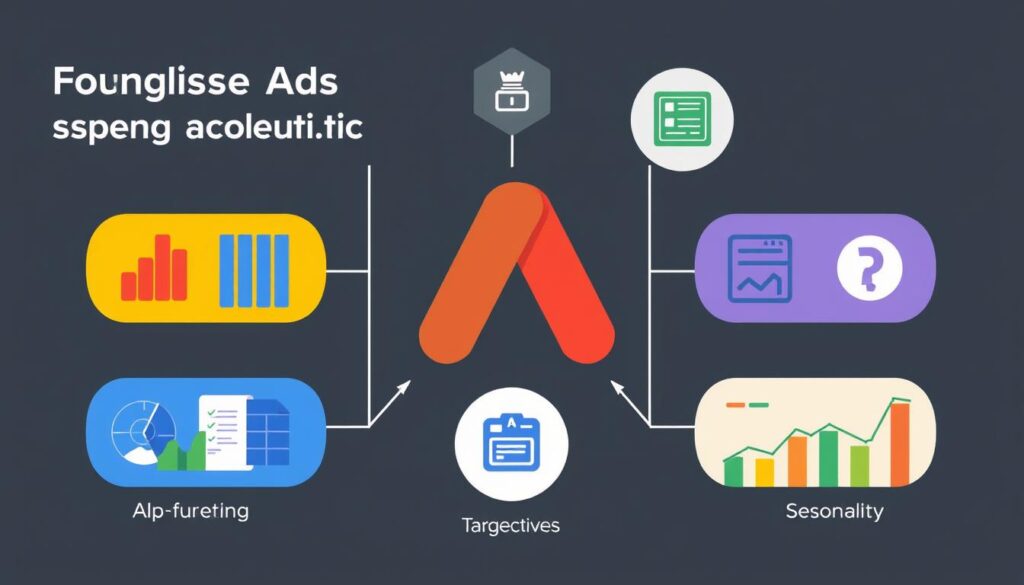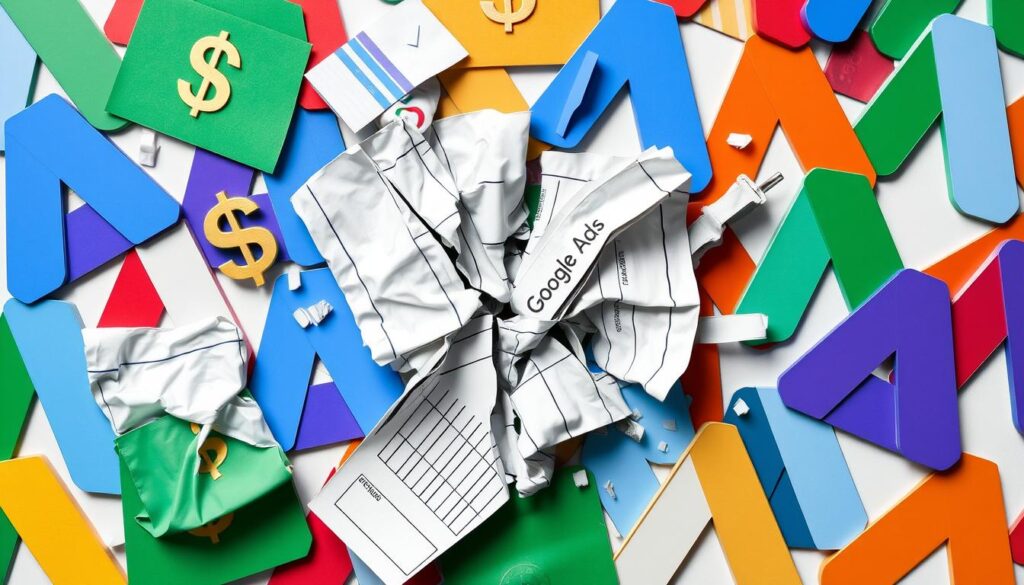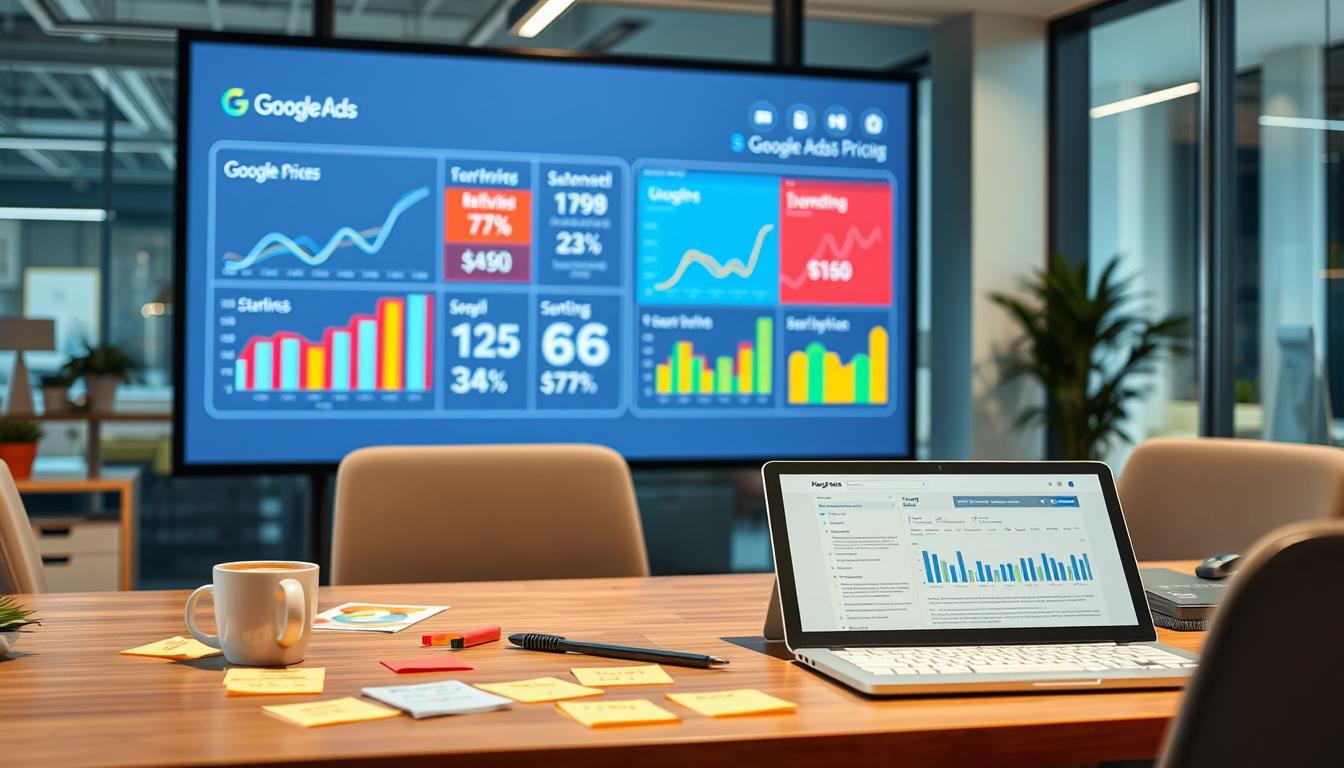Digital advertising can be tough to understand, especially with Google Ads costs. Whether you run a small business or work in marketing, knowing Google Ads pricing is key. It helps you get the most from your ad spend and reach your goals.
In this guide, we’ll cover what affects Google Ads costs. We’ll look at pricing models and industry standards. By the end, you’ll know what it takes to use Google Ads and how to make your budget work harder.
Key Takeaways
- Google Ads pricing is based on a cost-per-click (CPC) model, with various bidding strategies and quality score factors influencing your actual costs.
- Minimum budget requirements for Google Ads can vary, but a daily budget of at least $10-15 is generally recommended to get started.
- Factors such as industry, competition, and geographic location can significantly impact your Google Ads spending.
- Optimizing your Google Ads budget through smart strategies, cost-saving techniques, and performance monitoring can help you achieve better ROI.
- Regularly reviewing and adjusting your Google Ads investment based on performance metrics is crucial to maximizing the effectiveness of your campaigns.
Understanding the Basics of Google Ads Pricing
To get the most out of Google Ads, you need to know the basics. This includes Cost-Per-Click (CPC), bidding strategies, and Quality Score. These factors all play a big role in how much you pay for ads.
Cost-Per-Click (CPC) Explained
The CPC is what you pay for each ad click. It changes based on your bid, how competitive your industry is, and how well your ad matches the search. Knowing how to manage your CPC can help you save money on Google Ads.
Different Bidding Strategies Available
Google Ads has many bidding strategies to fit your goals and budget. You can choose from manual CPC to automated options like Target CPA and Target ROAS. Picking the right strategy is key to managing your ad costs well.
Quality Score Impact on Costs
Your Quality Score affects your ad costs too. A higher score means lower CPCs because Google likes ads that offer a good user experience. Improving your ad quality and targeting can boost your Quality Score and lower your Google Ads costs.
Knowing these basics helps you make smart choices in Google Ads. Understanding CPC, bidding strategies, and Quality Score can help you get the most out of your ads. This way, you can make your advertising more efficient and cost-effective.
Minimum Budget Requirements for Google Ads
Setting the right budget is key for a successful Google Ads campaign. The minimum budget needed can change based on your industry, target audience, and goals. Experts suggest starting with a Google Ads minimum budget of at least $500 per month for small to medium-sized businesses.
The starting costs for Google Ads depend on several factors. These include the competitiveness of your industry, the keywords you target, and your location. Markets with high competition or popular keywords may need a bigger PPC investment to stand out and drive sales.
- For basic campaigns targeting a local market, a $500 to $1,000 monthly budget is often a good starting point.
- Businesses with a broader geographic reach or more competitive industries may need to allocate a budget of $2,000 to $5,000 per month to see meaningful results.
- Larger enterprises or those operating in highly competitive niches may require an even higher monthly budget, often ranging from $10,000 to $50,000 or more.
The minimum budget needed is not the same for everyone. Your ideal budget will depend on your business goals, target audience, and marketing strategy. It’s wise to start small, watch how your campaigns perform, and then increase your investment as you improve your strategy.
“Starting with a realistic Google Ads budget is crucial for the long-term success of your campaigns. It’s better to start small and scale up as you learn and refine your strategy.”
Understanding the minimum budget requirements for Google Ads helps you plan better. This way, you can use your marketing budget wisely, aiming for better results for your business.
How Much Does It Cost to Do Google Ads: Breaking Down the Expenses
Running successful Google Ads campaigns requires understanding the costs. The total cost includes three main parts: initial setup, monthly management, and extra services. Each plays a key role in your PPC (Pay-Per-Click) advertising on Google.
Initial Setup Costs
Setting up a Google Ads account starts with important tasks. These include keyword research, ad copy creation, and setting up your campaign. These steps can cost from a few hundred to several thousand dollars. The cost depends on your business’s complexity and the needed expertise.
Monthly Management Fees
Keeping your Google Ads campaigns running smoothly takes time and skill. Many opt for PPC services or a digital marketing team. These services charge a monthly fee. The cost varies, from a few hundred to several thousand dollars, based on the campaign’s scope.
Additional Service Charges
You might also need extra services, like Google Ads expenses for advanced reporting or custom landing pages. These services add to your overall setup costs and management fees.
Knowing the different costs of Google Ads helps businesses plan better. This ensures they use their advertising management fees wisely and efficiently.
Factors Affecting Your Google Ads Spending
When it comes to ad spend factors, PPC cost variables, and Google Ads budget influencers, several key elements come into play. Knowing these can help advertisers spend wisely and get more from their PPC ads.
Industry competition is a big driver of Google Ads costs. The more competitive your field, the more you’ll have to bid to stand out. Also, who you’re trying to reach matters a lot. Targeting specific groups can cost more than aiming for a wider audience.
The quality of your ads and landing pages also affects your spending. Google’s Quality Score looks at relevance, user experience, and click-through rate. Keeping your ads and landing pages top-notch can help you save money.
Seasonality is another factor to consider. Some industries or products see more demand at certain times of the year. Knowing these patterns can help you manage your budget better.
| Factor | Impact on Ad Spend |
|---|---|
| Industry Competition | Higher competition leads to increased ad spend factors and PPC cost variables |
| Target Audience | Niche or specialized markets may have higher Google Ads budget influencers |
| Ad Quality | Higher quality ads and landing pages can reduce ad spend factors and PPC cost variables |
| Seasonality | Fluctuations in demand can impact Google Ads budget influencers throughout the year |

By understanding and managing these ad spend factors, PPC cost variables, and Google Ads budget influencers, advertisers can make their spending more effective. This leads to better results from their PPC campaigns.
Industry-Specific Google Ads Cost Benchmarks
Google Ads can be tricky, with costs changing a lot by industry and location. Knowing these benchmarks is key for businesses to manage their budgets well and keep up with the competition.
B2B vs B2C Advertising Costs
B2B industries usually spend more on Google Ads than B2C ones. This is because B2B ads are more focused and valuable, with customers often spending more over time. B2B ads can cost between $2 and $6 per click. In contrast, B2C ads usually cost between $1 and $3 per click.
Competitive Industry Pricing
| Industry | Average CPC |
|---|---|
| Legal | $6 – $8 |
| Home Services | $4 – $6 |
| Finance | $3 – $5 |
| Retail | $1 – $2 |
Geographic Cost Variations
Google Ads costs also vary by where you’re targeting. Things like how many people live there, how competitive it is, and the local economy play a part. Cities and areas with strong economies usually cost more, while smaller or less competitive places might be cheaper.
By understanding these costs, businesses can make better choices for their Google Ads budgets. This helps them stay competitive and get the most out of their ads.
Hidden Costs and Common Pricing Pitfalls
Google Ads can be tricky to navigate, and many advertisers face unexpected costs. The setup and bidding might seem easy at first. But, hidden expenses and common mistakes can quickly drain your budget.
Hidden PPC costs are a big issue. These include fees for ad extensions, remarketing, and extra features. It’s important to know the pricing well and manage these extras to avoid overspending.
Another mistake is not optimizing your bidding. Advertisers might overbid on keywords or not adjust bids with market changes. This leads to unexpected ad expenses. It’s key to regularly check and tweak your bidding to keep costs in line with your goals.
- Hidden PPC costs, such as fees for ad extensions and remarketing, can significantly increase your overall ad spend if not managed carefully.
- Failing to optimize bidding strategies can result in overbidding and unexpected ad expenses, leading to budget overruns.
- Regularly reviewing and adjusting your bidding strategies, based on market conditions and campaign performance, is crucial for maintaining control over your Google Ads costs.
Knowing about these hidden costs and common mistakes helps advertisers improve their Google Ads campaigns. By staying alert and monitoring your performance, you can avoid surprises and get the most from your ads.

| Hidden Cost | Description | Potential Impact |
|---|---|---|
| Ad Extensions | Additional features like sitelinks, callouts, and structured snippets that can increase CPC. | Incremental increase in overall ad spend if not managed carefully. |
| Remarketing | Targeting users who have previously interacted with your website or ads. | Can lead to higher CPCs and unexpected ad expenses if not optimized. |
| Bidding Mistakes | Overbidding on keywords or failing to adjust bids based on market changes. | Budget overruns and reduced return on ad spend (ROAS). |
Optimizing Your Google Ads Budget for Better ROI
Getting the most out of your Google Ads is key for any digital marketing plan. By using smart budgeting, saving costs, and keeping an eye on performance, you can make your PPC work harder. This leads to real business growth.
Budget Allocation Strategies
Spreading your Google Ads budget wisely is crucial. Try using different ad types, targeting, and bidding to reach more people. Keep checking and tweaking your budget to make sure it’s going where it works best.
Cost-Saving Techniques
- Use Google Ads’ automated bidding to save money and reduce work.
- Update your keyword list often, focusing on the best and cheapest ones.
- Use smart Google Ads budget optimization like bid changes, ad timing, and targeting to lower CPC.
- Keep your ad creatives and landing pages sharp to boost quality scores and cut costs.
Performance Monitoring Tips
It’s vital to watch how your Google Ads campaigns do. Use Google Ads’ tools to track important stats like click-through and conversion rates. This helps you spot what’s working and what’s not, so you can make better choices and save money.
By using these smart budgeting, saving, and monitoring tips, you can get the most out of your Google Ads. This will help your business grow in a lasting way.
When to Increase or Decrease Your Google Ads Investment
Managing your Google Ads investment well is key to a strong return on your marketing. By watching your campaign’s performance closely, you can grow successful ads and cut costs on ones that don’t do well. This smart way of adjusting your PPC budget and scaling Google Ads campaigns helps improve your ad spend optimization for the long run.
If your Google Ads are making a profit, it might be time to spend more. This lets you reach more people, get more leads, and increase conversions. On the other hand, if some ads or keywords aren’t doing well, it’s wise to spend less on them. Move your budget to ads that are working better.
Looking at your Google Ads data often is important. It shows you things like click-through rates, conversion rates, and cost-per-acquisition. This helps you make smart choices about your ad spend optimization. By using data and being quick to change your scaling Google Ads campaigns, you make sure your budget works hard. This helps your business grow in a lasting way.
FAQ
What is the average cost for Google Ads?
FAQ
What is the average cost for Google Ads?
The cost of Google Ads varies a lot. It depends on your industry, how competitive it is, how relevant your ads are, and who you’re trying to reach. On the lower end, the average cost per click (CPC) is between
FAQ
What is the average cost for Google Ads?
The cost of Google Ads varies a lot. It depends on your industry, how competitive it is, how relevant your ads are, and who you’re trying to reach. On the lower end, the average cost per click (CPC) is between $1 and $2. For very competitive industries, it can be $20 or more.
How do I determine my Google Ads budget?
To figure out your Google Ads budget, think about your goals, who you want to reach, how competitive your industry is, and your overall marketing budget. A good starting point is $500 to $2,000 a month. But, it really depends on what you need and what you want to achieve.
What impacts the cost of my Google Ads campaigns?
Several things can affect your Google Ads costs. These include:
– How competitive your industry and keywords are
– How good your ads and landing pages are
– Who you’re targeting and how
– Your bidding strategy and where your ads show up
– Where you’re targeting geographically and on what devices
– Any trends or seasonality in your market
How can I optimize my Google Ads budget for better ROI?
To get better ROI from your Google Ads budget, you can:
– Spend more on ads that work well and less on those that don’t
– Use techniques like negative keywords and automated bidding to save money
– Keep an eye on how your campaigns are doing and make changes as needed
– Try different ads, landing pages, and targeting to make your ads more relevant
– Grow successful campaigns and cut back on ads that aren’t doing well
When should I increase or decrease my Google Ads investment?
Increase your Google Ads spending when:
– Your ads are making money and bringing in good leads or sales
– You see chances to reach new markets, products, or people
– Your competitors are spending more and you need to stay visible
Decrease your spending when:
– Your ads aren’t making money and aren’t bringing in good leads or sales
– Your target audience or industry is doing poorly
– You need to spend more on other marketing channels that are working better
and . For very competitive industries, it can be or more.
How do I determine my Google Ads budget?
To figure out your Google Ads budget, think about your goals, who you want to reach, how competitive your industry is, and your overall marketing budget. A good starting point is 0 to ,000 a month. But, it really depends on what you need and what you want to achieve.
What impacts the cost of my Google Ads campaigns?
Several things can affect your Google Ads costs. These include:
– How competitive your industry and keywords are
– How good your ads and landing pages are
– Who you’re targeting and how
– Your bidding strategy and where your ads show up
– Where you’re targeting geographically and on what devices
– Any trends or seasonality in your market
How can I optimize my Google Ads budget for better ROI?
To get better ROI from your Google Ads budget, you can:
– Spend more on ads that work well and less on those that don’t
– Use techniques like negative keywords and automated bidding to save money
– Keep an eye on how your campaigns are doing and make changes as needed
– Try different ads, landing pages, and targeting to make your ads more relevant
– Grow successful campaigns and cut back on ads that aren’t doing well
When should I increase or decrease my Google Ads investment?
Increase your Google Ads spending when:
– Your ads are making money and bringing in good leads or sales
– You see chances to reach new markets, products, or people
– Your competitors are spending more and you need to stay visible
Decrease your spending when:
– Your ads aren’t making money and aren’t bringing in good leads or sales
– Your target audience or industry is doing poorly
– You need to spend more on other marketing channels that are working better
